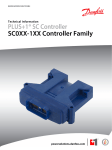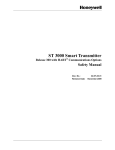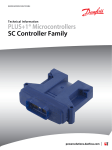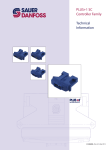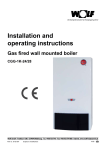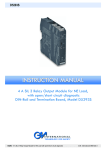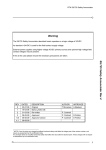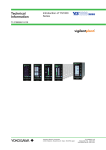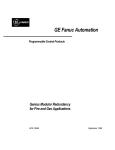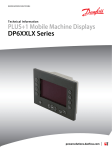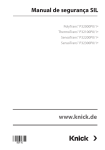Download PLUS+1® SC0XX-1XX Controller Family Safety Manual
Transcript
MAKING MODERN LIVING POSSIBLE Safety Manual PLUS+1® SC Controller SC0XX-1XX Controller Family powersolutions.danfoss.com Safety Manual PLUS+1 SC0XX-1XX Controller Family Revision history Table of revisions 2 Date Changed Rev December 2014 First edition AA L1420375 • Rev AA • December 2014 Safety Manual PLUS+1 SC0XX-1XX Controller Family Contents Introduction This safety manual............................................................................................................................................................................4 Certified SIL 2 Capable.............................................................................................................................................................. 4 Reference manuals..................................................................................................................................................................... 4 Model-specific API and data sheets......................................................................................................................................4 Latest version of technical literature....................................................................................................................................5 PLUS+1® SC Controller support................................................................................................................................................... 5 Component description and failure rates Processors and subsystems.......................................................................................................................................................... 6 FMEDA analysis................................................................................................................................................................................. 6 Failure categories description......................................................................................................................................................7 PLUS+1® SC Controller failure rates............................................................................................................................................8 Recommended diagnostics.......................................................................................................................................................... 8 Design considerations Safety critical function.................................................................................................................................................................... 9 Recommended diagnostics.....................................................................................................................................................9 User application software development requirements............................................................................................. 10 User application software development requirements (continued).....................................................................11 Environmental limits.....................................................................................................................................................................11 Application limits........................................................................................................................................................................... 11 Design verification.........................................................................................................................................................................11 SIL capability....................................................................................................................................................................................12 Systematic capability...............................................................................................................................................................12 Random capability................................................................................................................................................................... 12 Connection of the PLUS+1® SC Controller to sensors and actuators ......................................................................... 12 Requirements.................................................................................................................................................................................. 12 Installation and operation considerations Installation........................................................................................................................................................................................ 13 Physical location and placement ............................................................................................................................................ 13 Repair and replacement ............................................................................................................................................................. 13 Useful life...........................................................................................................................................................................................13 Software/hardware version numbers.....................................................................................................................................13 Security considerations................................................................................................................................................................13 Danfoss Power Solutions notification ................................................................................................................................... 13 Using the FMEDA results PFH calculation or PFDAVG calculation PLUS+1® SC Controller .....................................................................................14 Example application, failure rate analysis........................................................................................................................14 Abbreviations and definitions Abbreviations.................................................................................................................................................................................. 15 Definitions........................................................................................................................................................................................ 15 L1420375 • Rev AA • December 2014 3 Safety Manual PLUS+1 SC0XX-1XX Controller Family Introduction This safety manual This safety manual provides information necessary to design, implement, verify and maintain a safety critical function utilizing the PLUS+1® SC Controller. This manual provides necessary requirements for meeting the IEC 61508 functional safety standard. W Warning Read manual completely before programming your application. Certified SIL 2 Capable The SC0XX-1XX Controller Family is certified SIL 2 Capable when deployed with the certified SIL 2 Capable OS that is embedded in their respective SC0XX-1XX HWD files. The SC0XX-0XX Controller Family is designed for meeting the needs of SIL 2 applications where the OEM certifies at the machine level. The SC0XX-0XX Controller Family is not certified SIL 2 Capable as a component regardless of the HWD files with which it is deployed. The table below summarizes this information (the HWD filenames are representative, but not actual). In all cases, the OEM/customer is responsible for the safety integrity requirement, implementation, and validation of their application. Controller Family HWD for the Primary Processor HWD for the Secondary Processor Component-Level SIL 2 Capable Machine-Level SIL 2 Capable SC0XX-1XX SC0XX-1XX_HWD_Primary* SC0XX-1XX_HWD_Secondary* Yes SC0XX-1XX SC0XX-0XX_HWD_Primary SC0XX-0XX_HWD_Secondary No Yes SC0XX-0XX SC0XX-1XX_HWD_Primary* SC0XX-1XX_HWD_Secondary* No Yes SC0XX-0XX SC0XX-0XX_HWD_Primary SC0XX-0XX_HWD_Secondary Yes Yes No * These HWD files incorporate the certified SIL 2 Capable OS with Safety Diagnostic Functions. Reference manuals Manual Title Type Identification number PLUS+1® SC0XX-1XX Controller Family Technical Information L1415500 PLUS+1® GUIDE Software User Manual Operation Manual 10100824 How to Install PLUS+1® GUIDE Upgrades Operation Manual 11078040 Model-specific API and data sheets API and data sheet SC Controller model 4 Literature identification number Primary processor HW description—API Secondary processor HW description—API Data Sheet SC050-120/122 70156324 70156321 L1410421 SC024-120/122 70156499 70156500 L1410171 SC024-110/112 70156496 70156498 L1410890 SC050-13H 70153891 70153903 L1407546 L1420375 • Rev AA • December 2014 Safety Manual PLUS+1 SC0XX-1XX Controller Family Introduction Latest version of technical literature Danfoss product literature is online at: http://powersolutions.danfoss.com/literature/ PLUS+1® SC Controller support Contact information is online at: http://powersolutions.danfoss.com/products/PLUS-1-GUIDE/PLUS-1support-and-training/ L1420375 • Rev AA • December 2014 5 Safety Manual PLUS+1 SC0XX-1XX Controller Family Component description and failure rates Processors and subsystems The PLUS+1® SC Controller contains two processors, the primary and the secondary processor, which communicate asynchronously with each other. The PLUS+1® SC Controller has six main subsystems, each of which was analyzed individually. The configuration of a specific controller deployment is a function of the user application software. Analyzed subsystems Subsystem Description Common Logic Electrical components and circuitry typically involved with all applications regardless of the input-output channel configuration DIN/AIN/FreqIN Digital analog and frequency input pins CrntIn (current) Current input pins ResIN Resistance input pins DOUT Digital output pins CrntOUT (current) Current output pins FMEDA analysis The FMEDA analysis results include the elements shown in the following diagram (components and inputs/outputs are color coded, blue for the primary processor and red for the secondary processor). PLUS+1 SC Controller—Parts included in the FMEDA Connector Power input VLDP Protection and power supplies Power return Comparator check V ref 14 V 3 V 5 V CAN1 PWM shut-off [1:8] Secondary processor 3V (supply and reference) Clock 2 Inputs [1:24] Input conditioning CAN1 Shut-off check [1:14] Voltage supervisor 2 3V Clock 1 DOUT shut-off [1:6] Reset Async COM Voltage supervisor 1 Primary processor CAN2 Outputs Power return DOUT status feedback [1:6] DOUT control [1:6] Sensor power PWM outputs [1:8] PWM current feedback [1:8] PWM control [1:8] External memory DOUT [1:6] The PLUS+1® SC Controller is classified as a Type B1 high demand mode component in accordance to IEC 61508. The hardware fault tolerance is a function of the system architecture which will vary by application. The PLUS+1® SC Controller is certified to provide a 1oo1D architecture in accordance with IEC 61508. This allows the conclusion that a CAT2 architecture, in accordance with ISO 13849 or ISO 25119 can be implemented. For example this can be accomplished by using the primary processor as main controller for the Safety Function and the secondary processor as diagnostic element (intelligent watch dog, TE1 6 Type B component: “Complex” element (using microcontrollers or programmable logic); for details see 7.4.4.1.3 of IEC 61508. L1420375 • Rev AA • December 2014 Safety Manual PLUS+1 SC0XX-1XX Controller Family Component description and failure rates Test Equipment) to observe the correct function of the primary processor and to de-energize (safe-state) independently all corresponding safety-related outputs. Detailed analysis, review and documentation for compliance to ISO 13849 or ISO 25119 has to be done by the designer or integrator of the safety related system. Failure categories description In order to judge the failure behavior of the PLUS+1® SC Controller, the following definitions for the failure of the component apply. Definitions for failure of the component Failure category(1) Definition Fail-Safe State State where the safety output is de-energized. Fail Safe State where the safety output is de-energized. Fail Detected Failure that is detected by the PLUS+1® SC Controller and causes the output signal to go to the predefined fail safe state. Fail Dangerous Failure that deviates the measured input state or the actual output by more than the safety accuracy (2% of span) and that leaves the output within the active range. Fail Dangerous Undetected Failure that is dangerous and that is not being diagnosed by automatic diagnostics or expected user logic. Fail Dangerous Detected Failure that is dangerous but is detected by automatic diagnostics or is expected to be detected by user logic. Fail High(2)(3) Failure that causes a safety input signal to go to a value that is clearly above the normal range and can therefore be reliably detected by the user application software. Fail Low(2)(3) Failure that causes a safety input signal to go to a value that is clearly below the normal range and can therefore be reliably detected by the user application software. No Effect Failure of a component that is part of the safety function but that has no effect on the safety function. Annunciation Detected Failure that does not directly impact safety but does impact the ability to detect a future fault (such as a fault in a diagnostic circuit) and that is detected by internal diagnostics. Annunciation Undetected Failure that does not directly impact safety but does impact the ability to detect a future fault (such as a fault in a diagnostic circuit) that is not detected by internal diagnostics. λSD Failure rate of all safe detected failures λSU Failure rate of all safe undetected failures λDD Failure rate of all dangerous detected failures λDU Failure rate of all dangerous undetected failures λD Failure rate of all dangerous failures, detected and undetected AD Failure rate of all annunciation detected failures AU Failure rate of all annunciation undetected failures FIT Failure In Time (1x10-9 failures per hour) (1) The failure categories listed above, expand upon the categories listed in IEC 61508, which are only safe and dangerous, both detected and undetected. In IEC 61508, the No Effect failures cannot contribute to the failure rate of the safety function. Therefore, they are not used for the Safe Failure Fraction calculation. (2) Depending on the application, a Fail High or a Fail Low failure can either be safe or dangerous and may be detected or undetected depending on the user software application program. (3) Consequently, during a Safety Integrity Level (SIL) verification assessment, the Fail High and Fail Low failure categories need to be classified as safe or dangerous, and as detected or undetected. L1420375 • Rev AA • December 2014 7 Safety Manual PLUS+1 SC0XX-1XX Controller Family Component description and failure rates PLUS+1® SC Controller failure rates The results of the FMEDA analysis for the PLUS+1® SC Controller are presented in the following table. Failure rates (FIT) Controller Subsystem λSD λSU λDD λDU Common Logic 2451 16 2556 263 DIN/AIN/FreqIN 0 11 0 22 CrntIn (current) 0 5 0 5 ResIN 0 11 0 11 DOUT 73 38 28 1 CrntOUT (current) 143 1 36 10 Recommended diagnostics The PLUS+1® SC Controller can be implemented with diagnostics to detect many dangerous failures and other failures that would result in the controller operating in a degraded mode. The machine integrator is responsible for the safety and compliance to relevant standards. See Safety critical function on page 9 for design considerations and diagnostics recommendations. 8 L1420375 • Rev AA • December 2014 Safety Manual PLUS+1 SC0XX-1XX Controller Family Design considerations Safety critical function The PLUS+1® SC Controller can perform a wide variety of control functions. If these control functions of the primary processor are safety critical, then additional safety reliability can be achieved by configuring the secondary processor to monitor the sensor inputs, perform diagnostics, and act to bring the machine to a safe state if safe operating parameters are violated. The recommended configuration is to use the secondary processor to monitor the control function of the primary processor. Recommended diagnostics The following table lists recommended diagnostics. These diagnostics are implemented in the user application software that would be loaded into the PLUS+1® SC Controller. W Warning If these diagnostics are not implemented, then all dangerous failures should be treated as dangerous undetected failures. Diagnostics Function Failure mode Condition Action Continuous or Start-up Sensor power Short to battery Analog reading at or near maximum Stop reading inputs powered by sensor power. Continuous Sensor power Short to ground Analog reading at or near zero Stop reading inputs powered by sensor power. Continuous Sensor power Out of range Analog reading different than expected Can compensate inputs for new voltage if possible Continuous Analog input At Max Analog reading at or near max Stop using this input Continuous Analog input At zero volts Analog reading at or near zero Stop using this input Continuous Current driver Load shorted Duty cycle at least 50% less than expected for known load Information only or turn off output Continuous Current driver Load shorted Status signal indicates short circuit Turn off output immediately Continuous Current driver Open load Duty cycle at least 50% less than expected for known load Information only or turn off output Start-up Current driver Incorrect load Coil resistance is greatly different than expected Do not use that output Continuous Digital input Load shorted Status signal indicates short circuit or open load Application dependent Continuous Digital input Open load Status signal indicates short circuit or open load Application dependent Continuous Battery Power Dangerously High Battery voltage reading above 36V Turn off all outputs and ignore inputs Continuous Battery Power Dangerously Low Battery voltage reading below 7V Turn off all PWM outputs Continuous Frequency input Open Analog reading is at or near middle voltage Ignore frequency input Continuous Frequency input No signal Analog value doesn't change Ignore frequency input for longer than the maximum period Continuous L1420375 • Rev AA • December 2014 9 Safety Manual PLUS+1 SC0XX-1XX Controller Family Design considerations Diagnostics (continued) Function Failure mode Condition Action Continuous or Start-up CAN Bus off CAN bus status signal indicates bus off Turn off outputs that rely on CAN information Continuous CAN Time out An expected message hasn't Turn off outputs that rely on been received in the that message expected time Continuous CAN Failed transition Application requests message transmission while pending flag is active Continuous Configuration Invalid configuration Status signal indicates input Make change to application or output is configured in an software invalid way. Application dependent Start-up User application software development requirements W Warning The application programmer must apply these software development requirements when developing their safety-related system to insure the most robust safety integrity of the system architecture. • • • • • • • • • • • • • • • • • 10 CAN bus must not be used for safety critical functions, unless CAN-BE-SAFE protocol/product from Danfoss is deployed. All changes made to the configuration through the service tool must be verified by the user to ensure that they function as expected in the safety controller. The system must be designed with de-energized as the safe state. Appropriate action must be taken to put the system into a safe state when an output to outputfeedback mismatch error is identified by the application. The user application software must include plausibility checks on frequency input data to detect possible failures in frequency input calculations. EEPROM data must include software part number and the user application software should check that this matches with the application. The user application software must include plausibility checks on all safety relevant inputs. If data is shared between the primary and secondary processors through the internal UART, time monitoring must be used to ensure that messages are being sent within the expected time period. The user application software must take appropriate action to put the system into a safe state when a current feedback reading mismatch is reported. If the user application allows it, the current output must periodically be set to zero to allow the zero offset to be recalculated. For optimal performance, the output current should be set to zero after large temperature changes (> 25° C (77° F)) to allow the zero offset to be re-calculated If the checksum on the EEPROM fails, the user application software must shutdown outputs (deenergize) depending on the EEPROM data or use default data if that can be done safely. Redundant channels must be utilized to provide reliability where there is concern about channel reliability based on PFH. Signal comparisons must be implemented by the user application software to compare signals between primary and secondary processors for safety related signals. Function blocks from the Safety Library can help with this task. Wiring of the control must be done in compliance with the Danfoss wiring guidelines addressed in PLUS+1® SC0XX-1XX Controller Family Technical Information, L1415500. The user application software must implement strategies to mitigate against the effects of corrupted RAM. For example, include shadow copies of safety critical data and checksums of data. Internal UART communication implemented by user application software must have as a minimum control mechanism of a heartbeat with sequence signal. L1420375 • Rev AA • December 2014 Safety Manual PLUS+1 SC0XX-1XX Controller Family Design considerations User application software development requirements (continued) W Warning The application programmer must apply these software development requirements when developing their safety-related system to insure the most robust safety integrity of the system architecture. • • • • In all cases, the sensor power supply must be monitored and taken into a ratiometric calculation for the analog inputs. The user application software must implement shutdown of safety critical outputs either by the primary or the secondary processor or by both processors based on user application software safety requirements. The user application software must be tested for proper function including fault insertion testing. For more details, see the topic Software Safety Validation and the chapter Risk Reduction in the PLUS+1® GUIDE User Manual, 10100824. The user application software must be tested for proper response to: ‒ Highest frequency input conditions. ‒ Highest frequency output conditions. ‒ Highest CAN traffic load conditions on the corresponding used CAN buses. • • • • • • The user application software must verify that the OSExecTimeout can meet the process safety time. The OS.ChecksumFailureTreatment parameter allows the user application software to override memory corruption faults and to continue operation instead of turning off all outputs. The user application software must not override faults, since doing so could result in an unsafe condition. The user application software must verify that either the primary or the secondary processors or both processors are capable of disabling the safety related outputs. The user application software must use the frequency values and the count value of the Quad encoder inputs to validate functionality. The user application software must verify that the current output overload status returns to zero after commanding zero current output. A Functional Safety Assessment must be conducted before designing any safety related system using the PLUS+1® SC Controller. Environmental limits The designer or integrator of a safety critical function must verify that the safety controller is rated for use within the expected environmental limits of the target application. Refer to Model-specific API and data sheets on page 4 for the model-specific PLUS+1® SC Controller Data Sheet, for environmental limits. Application limits The designer or integrator of a safety critical function must check that the safety controller is rated for use within the expected application limits. Refer to the PLUS+1® SC0XX-1XX Controller Technical Information, L1415500, for safety controller limits. Design verification Refer to PLUS+1 SC Controller failure rates on page 8 for a summary of failure rates for the PLUS+1® SC Controller. The achieved Safety Integrity Level (SIL) of an entire Safety Critical Function design must be verified by the designer or integrator via a calculation of PFH considering the I/O required, demand mode, any implemented diagnostics, safety time, and architecture. The failure rate data listed the FMEDA report is only valid for the useful lifetime of a PLUS+1® SC Controller. The failure rates will increase sometime after this useful lifetime period. Reliability calculations based on the data listed in the FMEDA report for mission times beyond the lifetime may yield results that are too optimistic, in other words, the calculated Safety Integrity Level will not be achieved. L1420375 • Rev AA • December 2014 11 Safety Manual PLUS+1 SC0XX-1XX Controller Family Design considerations SIL capability Systematic capability The systematic capability of the PLUS+1® SC0XX-1XX Controller Family is SC 2 per IEC 61508. Random capability Refer to PLUS+1 SC Controller failure rates on page 8 for a summary of failure rates for the PLUS+1® SC Controller. For each user application, the failure rates for the particular configuration should be determined and compared to the allowable failure rate for a given SIL target. Connection of the PLUS+1® SC Controller to sensors and actuators The connection of the PLUS+1® SC Controller to the required sensors and actuators must be performed in accordance with the PLUS+1® SC0XX-1XX Controller Family Technical Information, L1415500. Requirements • • • • • The system’s response time must be less than the process safety time defined by the user application. The worst-case response time for a change of value of an analog input or contact signal (measured at the terminals) through the complete system to the completion of change of state of the analog output or contact output (measured at the terminals) will be a maximum of 10 ms plus the user application software programmed ExecTimeOut, as measured to the standard outputs. This worst case time must be determined for the worst-case loading of the safety controller. See Model-specific API and data sheets on page 4. The diagnostic self-checks other than the RAM diagnostic self-test and CRC on Flash application must be performed based on demand every loop time, the delay time from the onset of a failure to the time at which the outputs reach the safe state will be a maximum of 10 ms plus the user application software program parameter, ExecTimeOut. The time interval of RAM diagnostic self-check for the platform is a maximum of 1 hour. The time interval RAM test is reported to the user application software. The CRC flash check time for the user application software is a maximum of 1 hour and is reported to the user application software. Diagnostics and response times • • • • • 12 Description Worst case time Additional information Diagnostics and Response Times 1 hour Depends on total size of RAM Flash CRC error detect from onset to 1 hour safe state Depends on total size of Flash memory Change of input to output 10 ms Not including ExecTimeOut Diagnostic error detection time from onset to safe state 10 ms Diagnostics are based on demand during execution loop The maximum delay time from the onset of a failure to the time at which the outputs reach the safe state is the diagnostic time interval plus 10 ms. All safety related system components, including the PLUS+1® SC Controller, must be operational before machine operation. Personnel must verify that the PLUS+1® SC Controller is suitable for use in safety applications by confirming the PLUS+1® SC Controller’s nameplate is properly marked. Personnel performing testing on the PLUS+1® SC Controller must be competent to perform such testing. Functional Safety Training is provided by Danfoss Power Solutions, and details can be found on the Danfoss Power Solutions website at: http://powersolutions.danfoss.com/solutions/Functionalsafety/. Results from the functional tests and diagnostics must be recorded and reviewed periodically. L1420375 • Rev AA • December 2014 Safety Manual PLUS+1 SC0XX-1XX Controller Family Installation and operation considerations Installation The PLUS+1® SC Controller must be installed per standard practices outlined in the PLUS+1® SC0XX-1XX Controller Family Technical Information, L1415500. The environment must be checked to verify that environmental conditions do not exceed the ratings. Instructions on installation of latest version of the safety controller HWD file are found in How to Install PLUS+1® GUIDE Upgrades Operation Manual, 11078040. Physical location and placement The PLUS+1® SC Controller must be mounted in accordance with the PLUS+1® SC0XX-1XX Controller Family Technical Information, L1415500, in a low vibration environment. If excessive vibration is expected, special precautions must be taken to ensure the integrity of electrical connections or the vibration should be reduced using appropriate damping mounts. Repair and replacement The PLUS+1® SC Controllers are not repairable and no maintenance of them is required. Useful life The useful life of the PLUS+1® SC Controller is 30 years. No proof tests are required. Software/hardware version numbers See the Application Interface Document for the relevant PLUS+1® SC Controller, Model-specific API and data sheets on page 4. Security considerations The PLUS+1® SC Controller does not use data that the user can configure externally, for example, by the PLUS+1 Service Tool. The user application software may contain data that is configured externally. If this is the case, then suitable security should be provided. The PLUS+1® GUIDE Software User Manual, 10100824 provides a description of how to handle parameters in a safe way. Danfoss Power Solutions notification Any failures that are detected and that compromise functional safety should be immediately reported to Danfoss Power Solutions. Any change suggestions for future improvements or new features can be forwarded to Danfoss Power Solutions: Contact information is online at: http://powersolutions.danfoss.com/products/PLUS-1-GUIDE/PLUS-1support-and-training/ L1420375 • Rev AA • December 2014 13 Safety Manual PLUS+1 SC0XX-1XX Controller Family Using the FMEDA results PFH calculation or PFDAVG calculation PLUS+1® SC Controller An average Probability of Failure per Hour (PFH) or an average Probability of Failure on Demand (PFDAVG), depending on the operating mode, must be determined for each Safety Critical Function. The total will include the failure rate of all sensors and actuators that are required to perform the function as well as the elements of the PLUS+1® SC Controller that are utilized. Since the elements of the controller subsystem vary based on the Safety Critical Function implemented, the contribution for the PLUS+1® SC Controller needs to be determined for each application. To demonstrate how to calculate the contribution of the PLUS+1® SC Controller, consider the example of a steering function that is safety critical. The steering function relies on a Steer Command that is transmitted by a joystick utilizing a single ResIN – Resistance Mode Input. The controller processes the input and controls the movement of the machine through a dual path control subsystem utilizing four CrntOUT outputs. This safety critical function would have an overall failure rate that is the sum of controller subsystems used which are: • (1) Common Logic • (1) ResIN • (4) CrntOUT (current) In a machine application, the safety critical function could be operating in high demand. In a high demand function, only the dangerous undetected failures are included when calculating the PFH. To be considered a high demand application, the diagnostics must be executed 10 times faster than the process safety time. Care must be taken when modeling a function as high demand. It is recommended that the designer or integrator review the requirements with Danfoss Power Solutions to help avoid understating PFH. Example application, failure rate analysis The following table is for an example application. Consider for this example, the function is a high demand system. Failure rate analysis for the example function Controller Subsystem Quantity λSD λSU λDD λDU Total λD Common Logic 1 2451 16 2556 263 2819 DIN/AIN/FreqIN 0 0 11 0 22 22 CrntIn (current) 0 0 5 0 5 5 ResIN 1 0 11 0 11 11 DOUT 0 73 38 28 1 29 CrntOUT (current) 4 143 1 36 10 46 3023 31 2700 314 3014 Example Total (Sum of Quantity multiplied by Column Value) The implementation of the recommended diagnostics (Section 3.1) affects the system failure rate. For example, if all recommended diagnostics are implemented, only the undetected failures (λDU) contribute to the failure rate, which is 314 FITS or 3.14x10-7 failures per hour. This results in a SFF of 94.8%, which is a SIL2 compliant system. If none of the recommended diagnostics are implemented, then all failures (λSD, λDU, λDD) are treated as undetected failures. In this example, the failure rate would then be 3014 FITs or 3.014x10-6 failures per hour, which does not meet the SIL2 requirement, but does meet the SIL1 requirements. 14 L1420375 • Rev AA • December 2014 Safety Manual PLUS+1 SC0XX-1XX Controller Family Abbreviations and definitions Abbreviations Abbreviations Abbreviation Definition EUC Equipment under control. FMEDA Failure modes, effects and diagnostic analysis. HFT Hardware fault tolerance. PFH Probability of failure per hour. PFDAVG Average probability of failure on demand. SFF Safe failure fraction, summarizes the fraction of failures which lead to a safe state and the fraction of failures which will be detected by diagnostic measures and lead to a defined safety action. SIF Safety instrumented function. SIL Safety integrity level. SRS Safety related system, implementation of one or more safety critical functions. An SRS is composed of any combination of sensor(s), control module(s), and actuator(s). DIN/AIN/FreqIN Digital analog and frequency input pins. CrntIn (current) Current input pins. ResIN Resistance input pins. DOUT Digital output pins. CrntOUT (current) Current output pins. OS Operating system. Definitions Definitions Term Definition Continuous Demand Mode Mode where the safety function retains the equipment under control in a safe state as part of its normal operation. High Demand Mode Mode where the safety function is only performed on demand, in order to transfer the EUC into a specified safe state, and where the frequency of demands is greater than one per year. Low Demand Mode Mode where the safety function is only performed on demand, in order to transfer the EUC into a specified safe state, and where the frequency of demands is not greater than one per year. NOTE: The E/E/PE safety-related system that performs the safety function normally has no influence on the EUC or EUC control system until a demand arises. However, if the E/E/PE safety-related system fails in such a way that it is unable to carry out the safety function, then it may cause the EUC to move to a safe state (see 7.4.6 of IEC 61508). Safety Freedom from unacceptable risk of harm. Functional Safety The ability of a system to carry out the actions necessary to achieve or to maintain a defined safe state for the equipment, machinery, plant, and apparatus under control of the system. Basic Safety The equipment must be designed and manufactured such that it protects against risk of damage to persons by electrical shock and other hazards and against resulting fire and explosion. The protection must be effective under all conditions of the nominal operation and under single fault conditions. Safety Assessment The investigation to arrive at a judgment, based on evidence of the safety achieved by safety-related systems. Safety Critical Function A set of equipment intended to reduce the risk due to a specific hazard. L1420375 • Rev AA • December 2014 15 Safety Manual PLUS+1 SC0XX-1XX Controller Family Abbreviations and definitions Definitions (continued) 16 Term Definition Process Safety Time The period of time between a failure occurring in the control system (with the potential to give rise to a hazardous event) and the occurrence of the hazardous event if the safety function is not performed. Type A Component Non-Complex element (using discrete elements); for details see 7.4.4.1.2 of IEC 61508. Type B Component Complex element (using micro controllers or programmable logic); for details see 7.4.4.1.3 of IEC 61508. Common Logic Electrical components and circuitry typically involved with all applications regardless of the input-output channel configuration. L1420375 • Rev AA • December 2014 Safety Manual PLUS+1 SC0XX-1XX Controller Family L1420375 • Rev AA • December 2014 17 Safety Manual PLUS+1 SC0XX-1XX Controller Family 18 L1420375 • Rev AA • December 2014 Safety Manual PLUS+1 SC0XX-1XX Controller Family L1420375 • Rev AA • December 2014 19 Products we offer: • • • • • • • • • • • • • • • • Bent Axis Motors Closed Circuit Axial Piston Pumps and Motors Displays Electrohydraulic Power Steering Electrohydraulics Danfoss Power Solutions is a global manufacturer and supplier of high-quality hydraulic and electronic components. We specialize in providing state-of-the-art technology and solutions that excel in the harsh operating conditions of the mobile off-highway market. Building on our extensive applications expertise, we work closely with our customers to ensure exceptional performance for a broad range of off-highway vehicles. We help OEMs around the world speed up system development, reduce costs and bring vehicles to market faster. Danfoss – Your Strongest Partner in Mobile Hydraulics. Hydraulic Power Steering Go to www.powersolutions.danfoss.com for further product information. Integrated Systems Wherever off-highway vehicles are at work, so is Danfoss. We offer expert worldwide support for our customers, ensuring the best possible solutions for outstanding performance. And with an extensive network of Global Service Partners, we also provide comprehensive global service for all of our components. Joysticks and Control Handles Microcontrollers and Software Open Circuit Axial Piston Pumps Orbital Motors Please contact the Danfoss Power Solution representative nearest you. PLUS+1® GUIDE Proportional Valves Sensors Steering Transit Mixer Drives Comatrol www.comatrol.com Schwarzmüller-Inverter www.schwarzmuellerinverter.com Local address: Turolla www.turollaocg.com Valmova www.valmova.com Hydro-Gear www.hydro-gear.com Daikin-Sauer-Danfoss www.daikin-sauer-danfoss.com Danfoss Power Solutions (US) Company 2800 East 13th Street Ames, IA 50010, USA Phone: +1 515 239 6000 Danfoss Power Solutions GmbH & Co. OHG Krokamp 35 D-24539 Neumünster, Germany Phone: +49 4321 871 0 Danfoss Power Solutions ApS Nordborgvej 81 DK-6430 Nordborg, Denmark Phone: +45 7488 2222 Danfoss Power Solutions (Shanghai) Co., Ltd. Building #22, No. 1000 Jin Hai Rd Jin Qiao, Pudong New District Shanghai, China 201206 Phone: +86 21 3418 5200 Danfoss can accept no responsibility for possible errors in catalogues, brochures and other printed material. Danfoss reserves the right to alter its products without notice. This also applies to products already on order provided that such alterations can be made without changes being necessary in specifications already agreed. All trademarks in this material are property of the respective companies. Danfoss and the Danfoss logotype are trademarks of Danfoss A/S. All rights reserved. L1420375 • Rev AA • December 2014 www.danfoss.com © Danfoss A/S, 2014




















